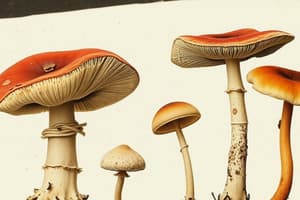Podcast
Questions and Answers
Over 100 species of mushrooms are considered edible.
Over 100 species of mushrooms are considered edible.
False (B)
Portobello mushrooms are a type of Crimini mushroom.
Portobello mushrooms are a type of Crimini mushroom.
True (A)
Mushrooms are a good source of carbohydrates.
Mushrooms are a good source of carbohydrates.
False (B)
Mushrooms can be found in aquatic environments.
Mushrooms can be found in aquatic environments.
Fungi are indicators of ecosystem decline.
Fungi are indicators of ecosystem decline.
Mushrooms play a crucial role in decomposition.
Mushrooms play a crucial role in decomposition.
Mushroom cultivation involves the process of harvesting before fruiting.
Mushroom cultivation involves the process of harvesting before fruiting.
Outdoor cultivation involves using controlled environments and substrates.
Outdoor cultivation involves using controlled environments and substrates.
Mushroom cultivation can be used for environmental remediation purposes.
Mushroom cultivation can be used for environmental remediation purposes.
Spawn production is the process of promoting mushroom growth and development.
Spawn production is the process of promoting mushroom growth and development.
Mushroom cultivation can be used for food production purposes.
Mushroom cultivation can be used for food production purposes.
Flashcards are hidden until you start studying
Study Notes
Edible Mushrooms
- Over 140 species of mushrooms are considered edible, but some can be poisonous if not cooked or prepared properly.
- Popular edible mushrooms include:
- Button mushrooms (Agaricus bisporus)
- Crimini mushrooms (Crimini)
- Portobello mushrooms (Agaricus bisporus)
- Shiitake mushrooms (Lentinula edodes)
- Oyster mushrooms (Pleurotus ostreatus)
- Morel mushrooms (Morchella spp.)
- Edible mushrooms can be used in a variety of dishes, including soups, salads, and sauces.
- They are a good source of protein, fiber, and various vitamins and minerals.
Mushroom Ecology
- Mushrooms play a crucial role in ecosystem function, including:
- Decomposition: breaking down organic matter and recycling nutrients
- Symbiotic relationships: forming mycorrhizal relationships with plants, providing nutrients in exchange for carbohydrates
- Nutrient cycling: facilitating the transfer of nutrients between organisms
- Mushrooms can be found in a variety of habitats, including:
- Forests: associated with trees and other vegetation
- Grasslands: found in soil and decaying organic matter
- Wetlands: thriving in aquatic environments
- Fungi, including mushrooms, are important indicators of ecosystem health and can be used to monitor environmental changes.
Mushroom Cultivation
- Mushroom cultivation involves:
- Spawn production: creating a substrate for mushroom growth
- Inoculation: introducing mushroom mycelium to the substrate
- Fruiting: promoting mushroom growth and development
- Harvesting: collecting mature mushrooms
- Methods of mushroom cultivation include:
- Indoor cultivation: using controlled environments and substrates
- Outdoor cultivation: using natural habitats and substrates
- Integrated pest management: using techniques to minimize pests and diseases
- Mushroom cultivation can be used for:
- Food production: providing a sustainable source of protein and nutrients
- Environmental remediation: using mushrooms to clean pollutants from soil and water
- Medicinal applications: harnessing the bioactive compounds of mushrooms for human health
Edible Mushrooms
- Over 140 species of mushrooms are considered edible, but some can be poisonous if not cooked or prepared properly.
- Popular edible mushrooms include:
- Button mushrooms (Agaricus bisporus)
- Crimini mushrooms (Crimini)
- Portobello mushrooms (Agaricus bisporus)
- Shiitake mushrooms (Lentinula edodes)
- Oyster mushrooms (Pleurotus ostreatus)
- Morel mushrooms (Morchella spp.)
- Edible mushrooms are a good source of protein, fiber, and various vitamins and minerals.
- They can be used in a variety of dishes, including soups, salads, and sauces.
Mushroom Ecology
- Mushrooms play a crucial role in ecosystem function, including decomposition, symbiotic relationships, and nutrient cycling.
- They break down organic matter and recycle nutrients through decomposition.
- They form mycorrhizal relationships with plants, providing nutrients in exchange for carbohydrates.
- They facilitate the transfer of nutrients between organisms through nutrient cycling.
- Mushrooms can be found in various habitats, including forests, grasslands, and wetlands.
- Fungi, including mushrooms, are important indicators of ecosystem health and can be used to monitor environmental changes.
Mushroom Cultivation
- Mushroom cultivation involves spawn production, inoculation, fruiting, and harvesting.
- Spawn production creates a substrate for mushroom growth.
- Inoculation introduces mushroom mycelium to the substrate.
- Fruiting promotes mushroom growth and development.
- Harvesting collects mature mushrooms.
- Methods of mushroom cultivation include indoor cultivation, outdoor cultivation, and integrated pest management.
- Mushroom cultivation can be used for food production, environmental remediation, and medicinal applications.
- It provides a sustainable source of protein and nutrients through food production.
- It can clean pollutants from soil and water through environmental remediation.
- It harnesses the bioactive compounds of mushrooms for human health through medicinal applications.
Studying That Suits You
Use AI to generate personalized quizzes and flashcards to suit your learning preferences.




